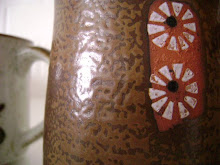Herbed Cashew Cheese
When I heard about making your own raw vegan cheese, I just had to try it. I'm always up for a little adventure in the kitchen! In both Vibrant Living by James Levin and Raw by Roxy Klien (see my review of this great book in a previous post), the authors give instructions on making nut cheeses. It really only requires just a few very simple ingredients and some time. See my comments below on how to make the cheese-making process safe and keep bad bacteria out of the cheese. There are a few phases to making cheese:
Step 1-making the rejuvalac:
Ingredients:
* 2 tablespoons wheat berries
* filtered water
Equiptment:
* a clean wide-mouth jar
* a piece of cheese cloth
* a rubber band
Start by combining the wheat berries and about 1 cup of water in the jar. Cover the opening of the jar with the cheesecloth and secure with the rubber band. Let sit overnight where the jar will not be disturbed.
First thing in the morning, drain the berries and rinse well, leaving the cheesecloth in place to keep the berries from escaping. Drain as much water as you can from the berries. Gently shake the jar on its side so that the berries spread out in a even layer. Place the jar on its side on a bowl or plate. Repeat this process of rinsing and draining three times per day for about 2 days until little white tails start to emerge from the berries.
Once the berries have begun to sprout, cover them with about 1/3 cup of filtered water and let them sit for 12 hours in a warm place (like near the stove). Cover the jar with a towel. This is the rejuvalac that will provide the good bacteria to the cheese. Note: if you don't want to make your cheese right away, the rejuvalac will keep in the fridge for 4-5 days.
Step 2 making the cheese:
Ingredients:
* 1 cup raw cashews
* filtered water
* 1/4-1/3 cup rejuvalac
* 1/4 teaspoon sea salt
* 2 tablespoons each: fresh parsley and chives, finely chopped
* 2 teaspoon lemon juice
Equiptment:
* blender
* clean cheese cloth
* bowl
* paper towels or clean tea towels
Soak the cashews in the filtered water for 8-12 hours. Drain them and combine them in the blender along with the rejuvalac and salt. Blend until smooth, adding more rejuvalac as needed to facilitate blending. Do not add too much liquid--you want a fairly thick mixture simmilar to cream cheese or goat cheese.
Transfer the mixture to a triple-thickness of cheesecloth. Secure the corners of the cheesecloth with a twist-tie or string, forming a little bundle. In the bottom of a small bowl, lay down a folded-up paper towel and place the cheese bundle on top. The paper towel will absorb the water from the cheese, so be sure to change it every few hours. Cover the bowl with a clean kitchen towel and place in a warm spot where it won't be disturbed. Let it sit for 12 hours.
After the 12 hours, pop the cheese from the cloth and mix in the herbs and lemon juice. Return the cheese to the cloth, bundle it up again and let chill in the fridge overnight.
I was very happy with the fruits of my labor. It is true, making raw cashew cheese is quite a process, but its worth it. The cheese is rich in good bacteria (don't worry, the chance of getting sick from this is slim if you #1: keep your hands clean, #2: use clean equiptment #3: don't let the rejuvalac or cheese ferment for more than 12 hours and #4: do not make cheese on hot summer days when the temp is above 90 degrees or so.) It is also rich in enzymes.
I thought the taste and texture was simmilar to cream cheese--slightly sweet and really creamy and rich. I loved the addition of the herbs and lemon. Serve this cheese with crackers, veggies, or dehydrated veggie chips. This recipe makes about 1 cup of cheese, but feel free to expand the recipe as needed.



